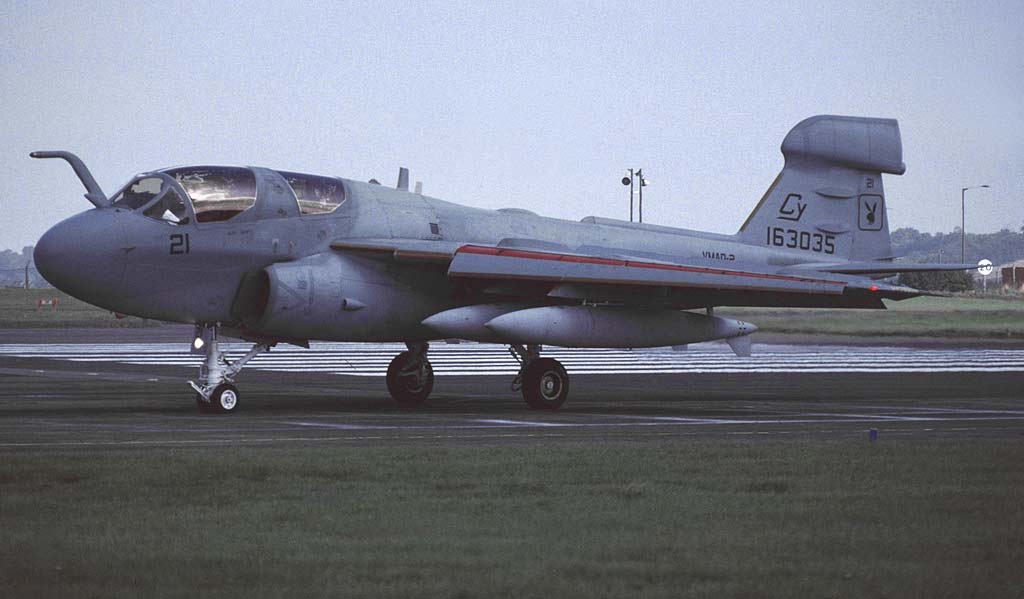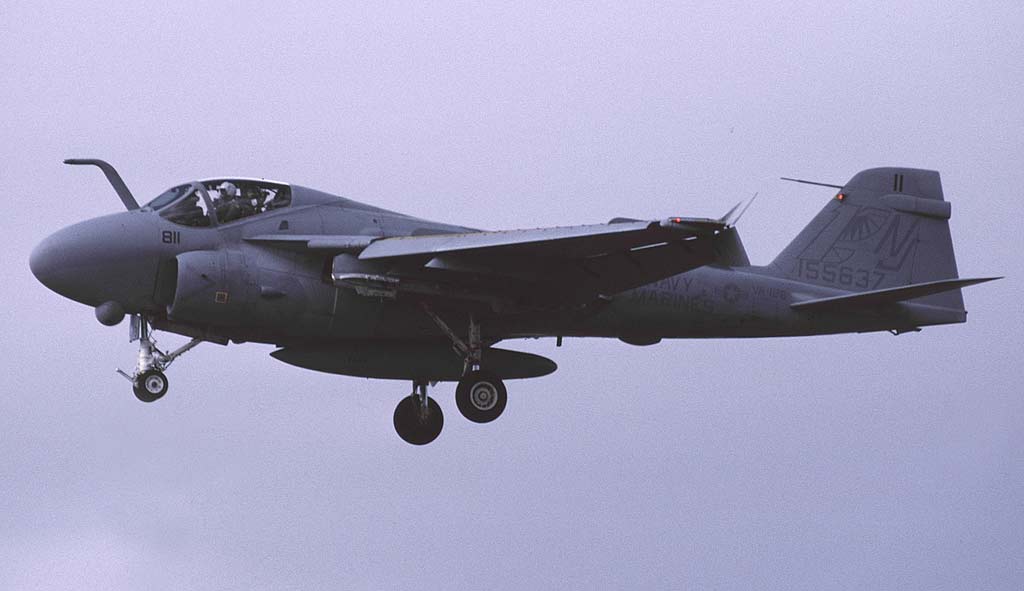The Grumman A-6 Intruder: a twin-engine, all-weather attack aircraft renowned for its role in delivering precision strikes under any conditions.
In Brief
The Grumman A-6 Intruder, developed in the 1960s, served as the US Navy and Marine Corps’ primary all-weather, medium-attack aircraft for over three decades. It was designed to carry large payloads of ordnance at long ranges, delivering them with high accuracy even in adverse weather conditions. The A-6’s sophisticated navigation and attack systems, combined with its ability to fly low-level missions in any weather, made it a formidable tool in the U.S. military’s arsenal. It featured a two-man crew, a twin-engine configuration, and was capable of delivering a variety of munitions, including precision-guided bombs, which enabled it to engage a wide range of tactical targets effectively.

History of the Development of the Grumman A-6 Intruder
The development of the Grumman A-6 Intruder was a response to the U.S. Navy’s requirement in the 1950s for an all-weather aircraft capable of precision bombing runs, particularly in the challenging conditions of low-altitude night and adverse weather missions. The era was marked by rapid advancements in aviation technology, alongside the escalating demands of Cold War military strategy, which necessitated a versatile and robust platform to carry out complex bombing missions.
Grumman Aerospace Corporation commenced the A-6 program to fulfill this need, with the prototype making its first flight on April 19, 1960. The design and development of the A-6 Intruder were driven by the necessity for an aircraft that could operate from aircraft carriers and deliver heavy ordnance loads accurately over long distances, regardless of weather conditions. This led to the creation of an aircraft with no direct NATO nickname, emphasizing its unique operational role.
The Intruder’s development was a significant leap in naval aviation, incorporating advanced avionics for navigation and targeting, which were revolutionary at the time, setting new standards for subsequent generations of military aircraft.
Design of the Grumman A-6 Intruder
The Grumman A-6 Intruder was ingeniously designed with a focus on low-altitude, all-weather operability, and substantial payload capacity. Its airframe was robust, enabling it to withstand the rigors of high-stress, low-altitude missions. The aircraft was powered by two Pratt & Whitney J52-P-8A turbojet engines, providing the necessary thrust to carry a wide array of ordnance over considerable distances.
One of the Intruder’s notable design features was its advanced navigation and attack system, known as the DIANE (Digital Integrated Attack/Navigation Equipment), which allowed for remarkable precision in targeting. The cockpit was designed for a crew of two, with the pilot and bombardier-navigator seated side by side, a layout that facilitated efficient communication and mission coordination.
The aircraft’s ability to carry up to 18,000 pounds (8,165 kilograms) of ordnance over a combat radius exceeding 500 miles (805 kilometers) was unparalleled at its introduction. However, the complexity and maintenance demands of its sophisticated avionics were among its few drawbacks, alongside the aircraft’s substantial size, which limited its agility compared to lighter attack aircraft.
Performance of the Grumman A-6 Intruder
The A-6 Intruder’s performance was characterized by its exceptional low-altitude penetration capabilities, enabling it to execute precise strikes under the cover of darkness or adverse weather conditions. Its twin-engine configuration ensured a maximum speed of 648 mph (1,043 km/h) and a service ceiling of 42,400 feet (12,924 meters), although its typical operational altitudes were much lower, enhancing its effectiveness in avoiding radar detection and enemy defenses.
The Intruder’s range and endurance were significant, with the ability to conduct extended missions over enemy territory, thanks in part to aerial refueling capabilities. This extended reach, combined with the aircraft’s advanced navigation and targeting systems, made it a formidable platform for interdiction, close air support, and strategic bombing missions, often outperforming contemporaneous aircraft in terms of payload capacity and all-weather operability.
Variants of the Grumman A-6 Intruder
The A-6 Intruder series included several variants, each designed to enhance the platform’s versatility and combat capabilities. The initial A-6A model was followed by the A-6B, designed to suppress enemy air defenses; the A-6C, equipped with specialized equipment for targeting in night operations; and the A-6E, the most advanced variant, featuring improved navigation and attack systems, and later, a capability for employing precision-guided munitions. The EA-6B Prowler, a specialized electronic warfare derivative of the Intruder, was developed to provide radio frequency jamming and electronic countermeasure capabilities.

Military Use and Combat of the Grumman A-6 Intruder
The A-6 Intruder was a cornerstone of U.S. naval aviation from the Vietnam War through to the 1990s, showcasing its operational flexibility in various combat scenarios. It was heavily utilized in Vietnam, where its ability to deliver precision strikes in challenging conditions proved invaluable. The Intruder participated in key operations, delivering munitions against enemy infrastructure, air defenses, and troop concentrations, often under intense anti-aircraft fire.
Throughout its service life, the Intruder was involved in numerous military engagements, including the Gulf War, where it conducted deep penetration strikes against Iraqi forces. Its adaptability was further demonstrated through its transition to conventional bombing roles, employing laser-guided bombs with high accuracy.
The aircraft was eventually phased out in favor of newer technology, notably the F/A-18 Hornet, which offered greater versatility and incorporated advancements in precision weaponry and avionics. Despite its retirement, the A-6 Intruder remains celebrated for its significant contributions to aerial combat and its role in shaping modern air attack strategies.
The Grumman A-6 Intruder distinguished itself as a pioneering force in all-weather, medium-attack military aviation. With its advanced navigational and targeting technology, substantial payload capacity, and robust design, it set a high standard for subsequent generations of attack aircraft. Its legacy endures in the annals of military aviation history, epitomizing the evolution of air-to-ground warfare capabilities and the strategic importance of carrier-based aircraft in projecting power and precision in combat operations.
Back to the Fighter Jet section.